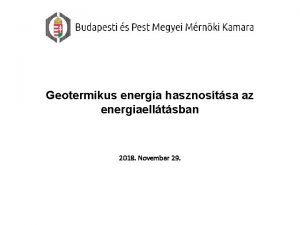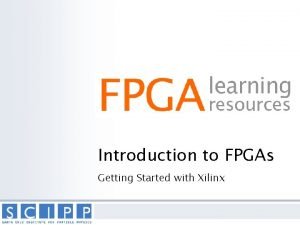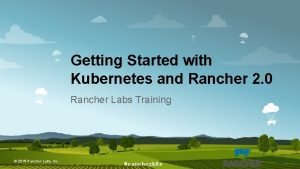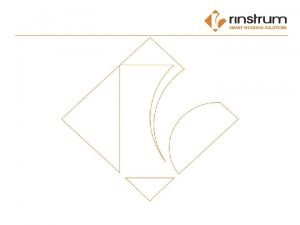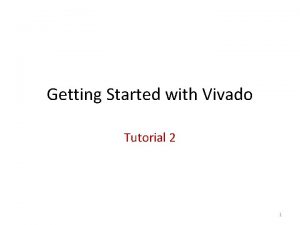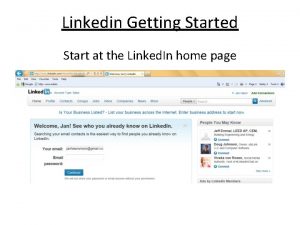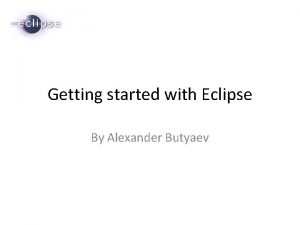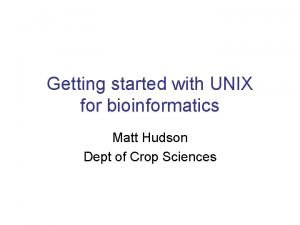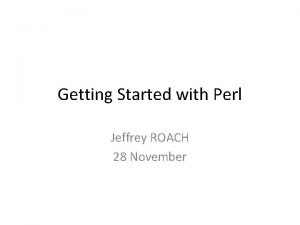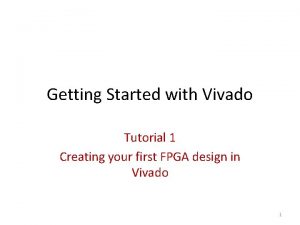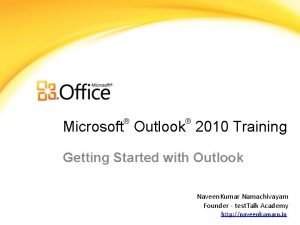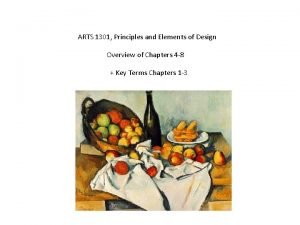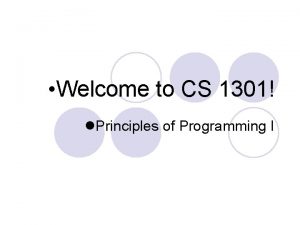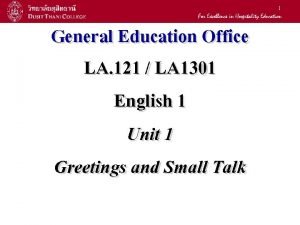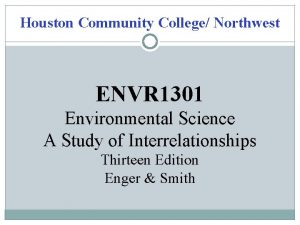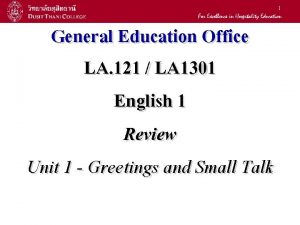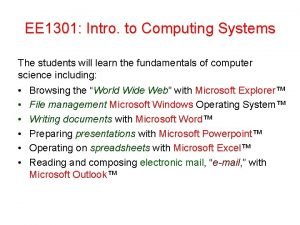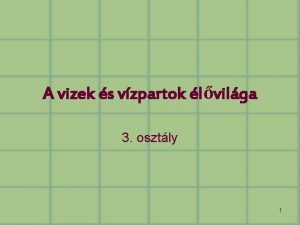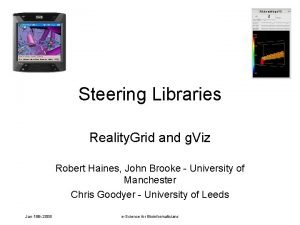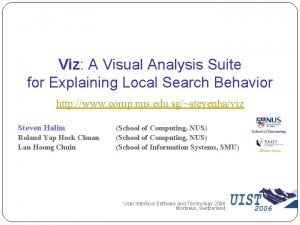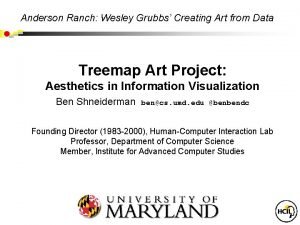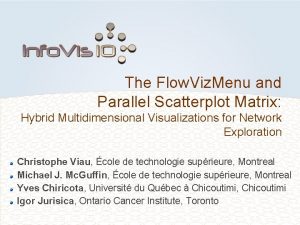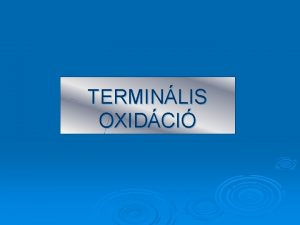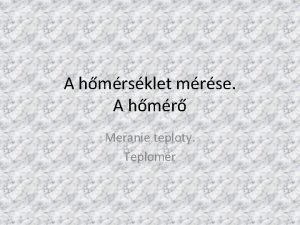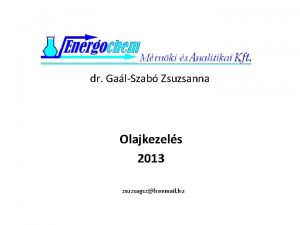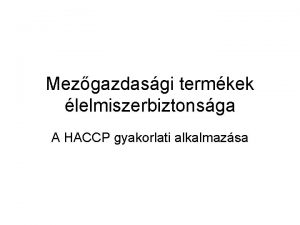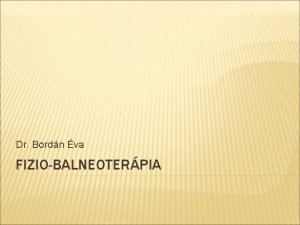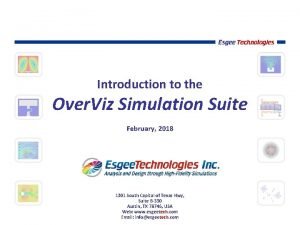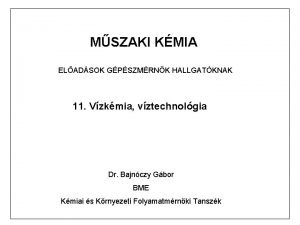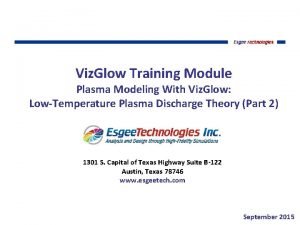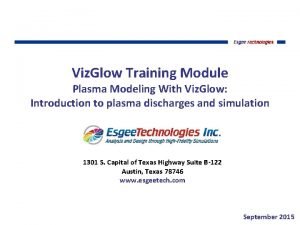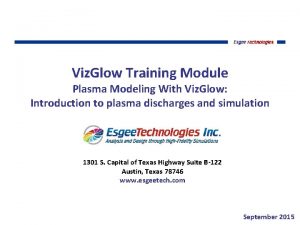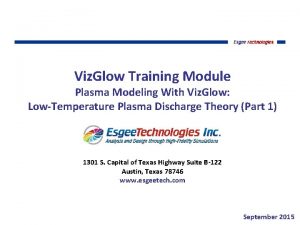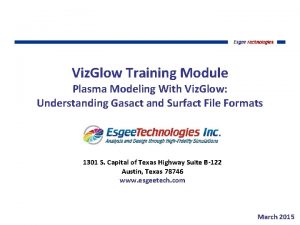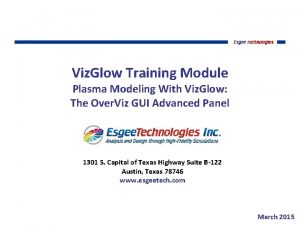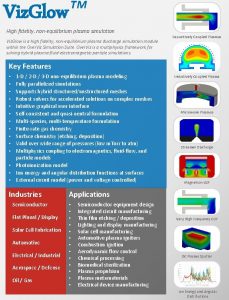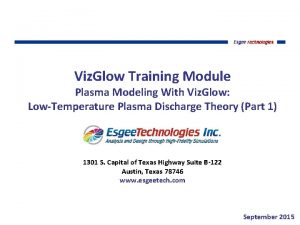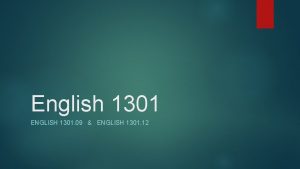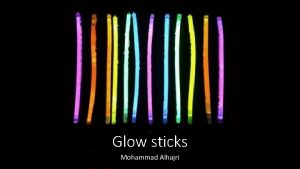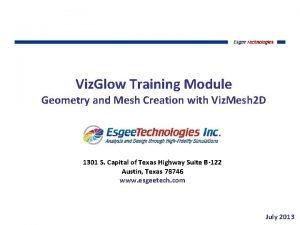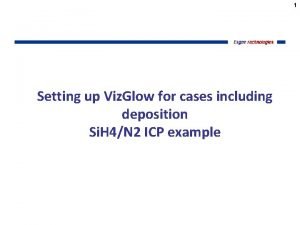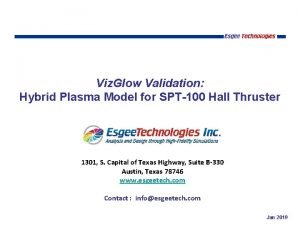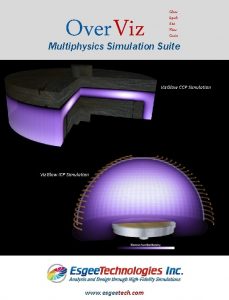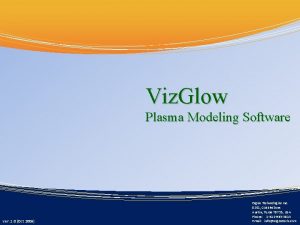Getting Started with Viz Glow Tutorial 1301 S




















































- Slides: 52

Getting Started with Viz. Glow Tutorial 1301 S. Capital of Texas Highway Suite B-122 Austin, Texas 78746 www. esgeetech. com

COPYRIGHT AND CONFIDENTIALITY STATEMENT Copyright © (2007 -2018) Esgee Technologies, Inc. All rights reserved. This manual accompanies software that is provided to users under a license agreement. This manual can also be provided under a non-disclosure agreement and is subject to restrictions on confidential information under such an agreement. The manual contains proprietary information and may not be disclosed to a third party not covered by the license agreement or a non-disclosure agreement. No part of this manual may be reproduced in any form or by any means without express written permission from Esgee Technologies, Inc. 2

Geometry and Operating Conditions Specifications for the 1 -D CCP problem Geometry Parallel plate plasma discharge Distance between electrodes: 40 mm Operating conditions Pressure: 50 m. Torr Power: 300 watts (cycle averaged power integrated over a wafer with diameter 300 mm) Frequency: 13. 56 MHz Gas: pure argon 3

Solving the 1 -D CCP problem Roadmap of the plasma simulation process Create a mesh file corresponding to given geometry Viz. Mesh 2 D (CGNS mesh format is also supported for third-party meshing software) Create a project with mesh file and given operating conditions Over. Viz Graphical User Interface Run the project until (periodic) steady state is reached Viz. Glow Visualize the results and post-processing Output formats: Tecplot, VTK Over. Viz Line Plot Utility 4

1 -D CCP: Creating a new project Select “New Project” from “File” menu, then choose a folder for the new project New folder can be created using “Make New Folder” button The path where the new project is created must not contain any spaces 5

1 -D CCP: Preliminary Dialog (1/3) Mesh input and equation selections After the new project folder is chosen, the preliminary dialog appears The input parameters used for this example are shown The mesh file used here is included with the Examples package For meshes made with Viz. Mesh 2 D, deleted boundary sections do not have to be specified Since this is a CCP problem at intermediate pressure (50 m. Torr), the selfconsistent model with ion momentum is the appropriate physical model 6

1 -D CCP: Preliminary Dialog (2/3) Mesh input and equation selections Select addition physics to include: External circuit 7

1 -D CCP: Preliminary Dialog (3/3) Gas and surface chemistry definitions The chemistry files used here are included with the Examples package For surface definitions, select the surface mechanism and click on the “Add->” button so the surface mechanism and data file appears on the right Once preliminary information has been entered, click on the “Submit” button Gas file = Ar_plasma_low. Pr_Maxw. Momcrs_gas. phs Property data = Ar_plasma_specdata. dbs Surface file = Ar_plasma_low. Pr_surf. phs 8

1 -D CCP: General Panel (1/4) Overview of General Panel The input parameters used for the general panel are shown (detailed explanations on slides that follow) 9

1 -D CCP: General Panel (2/4) Simulation type, time parameters and length scale parameters The Final time in this case is set to 1000 RF cycles (1000/13. 56 e 6 seconds) The entry boxes with green background are custom-user-expressions; in the case of DT, DT may be specified as a function of time T The Mesh length scale must be entered on the general panel. Recall that while making the mesh (on slide 6) we had decided 1 mesh unit = 1 mm 10

1 -D CCP: General Panel (3/4) Invoked and Gas subdomain selection All the subdomains defined in the mesh file will be shown under All meshed subdomains Subdomains on which at least one equation will be solved should be included in the list of invoked subdomains Subdomains where the gas chemistry species are present (where plasma is formed) should be included in the list of gas subdomains In this example, there is only one subdomain “plasma” on which all the equations are solved, so it is included in the list of invoked and gas subdomains 11

1 -D CCP: General Panel (4/4) Background gas properties selection The Background species is composed of one or more neutral species, that can be selected from the given list If Dominant background is selected, then the dominant background species density will be updated using the ideal gas law If Fixed background is chosen, then the species densities will be assumed constant and the ideal gas law is not used The operating Pressure(Pa) can be specified as a custom user expression CUX varying in space (X, Y, Z) and time (T) 12

1 -D CCP: Circuit Panel (1/6) Overview of Circuit Panel The input parameters used for the circuit panel are shown (detailed explanations on slides that follow) 13

1 -D CCP: Circuit Panel (2/6) Adding/Editing a circuit When the circuit equation is selected, a circuit is added by default (“external_circuit”) Circuits can be added by entering a name and clicking on the “Add” button If no external circuit is needed, then the external circuit equation can be removed from the Edit menu (Edit->Add/Remove equations) 14

1 -D CCP: Circuit Panel (3/6) Circuit settings, control type and connection boundaries In this example, we want to specify a fixed power, so the Supply control type is set to POWER_CONTROL It is assumed that the power supply is directly connected to the plasma discharge , which can be modeled with a zero series resistance The “bottom” boundary is the powered electrode and must be specified as a Circuit connection boundary section 15

1 -D CCP: Circuit Panel (4/6) Voltage waveforms and controller parameters For POWER_CONTROL, the Fixed voltage waveform can be left at zero, and the Variable voltage waveform must be specified. The amplitude of the voltage will be increased/decreased from the specified value until the required power is achieved If this was a VOLTAGE_CONTROL case, the Fixed voltage waveform would have to be specified and the Variable voltage waveform should be zero Recall we wanted a set point power of 300 W (cycle averaged power integrated over a wafer with diameter 300 mm) In our case the electrode area is 1 unit x 1 unit = 1 e-6 m 2 , for which the equivalent Cycle averaged power is 0. 004 W Typical values for the Power controller exponent are 0. 01 -0. 05 16

1 -D CCP: Circuit Panel (5/6) Voltage waveforms and controller parameters with CUP In the previous section we were able to set up a case using a sinusoidal wave form. However, many times, the user may have different types of waveforms. For these cases we import CUP files which can be loaded by clicking on the Custom-user-profile radio-button and then on the “Load Profile” button. These options are available for Fixed voltage waveform and Variable voltage waveform. In the CUP expressions the x-coordinate is the time scale (t) and the ycoordinate is the voltage scale (v) to be applied on the system. The CUP file format is the following: *BEGIN_PROFILE val 0_x val 0_y val 1_x val 1_y. . *END_PROFILE 17

1 -D CCP: Circuit Panel (6/6) Voltage waveforms and controller parameters with CUP The file labeling of the CUP expressions is: name_of_file. cup The file names “name_of_file” are used to identify them in the input file being generated to be later processed by Viz. Glow. These filenames should be unique. The CUP-expression contains expands for an entire wave length. Then this signal can be spread out in time depending on the type of simulation to be implemented. CUP files are helpful when dealing with square, triangle, and piecewise continuous signals. 18

1 -D CCP: Electrostatic Potential Panel (1/4) Overview of Electrostatic Potential Panel The input parameters used for the electrostatic potential panel are shown (detailed explanations on slides that follow) 19

1 -D CCP: Electrostatic Potential Panel (2/4) Specifying referenced subdomains The subdomains where the potential equation is solved have to be selected as referenced subdomains from the invoked subdomains list While solving self-consistent plasma problems, subdomains representing dielectric materials and gases are added as referenced subdomains for the electrostatic potential equation If quasi-neutral plasma is being solved, then only the gas subdomains (where plasma is present) would be referenced in the electrostatic potential equation 20

1 -D CCP: Electrostatic Potential Panel (3/4) Subdomain and boundary section properties To specify the subdomain properties, select a subdomain and enter the values of the quantities shown For this example, the default subdomain properties are applicable For the boundary sections, select each boundary section and specify boundary condition type and parameters as required 21

1 -D CCP: Electrostatic Potential Panel (4/4) Boundary condition and subdomain properties preview Once all boundary conditions are entered, they can be previewed using the Preview referenced boundary conditions button, and similarly for subdomains using the Preview referenced boundary subdomain properties button Since this is a 1 -D problem, the boundary conditions at “left” and “right” boundaries are set to SYMMETRY The “top” boundary is grounded (zero potential) 22

1 -D CCP: Species Density Panel (1/3) Overview of Species Density Panel The input parameters used for the species density panel are shown (detailed explanations on slides that follow) 23

1 -D CCP: Species Density Panel (2/3) Subdomain properties The species density equations are solved on all gas subdomains (selected on the general panel) To enter the initial density, first select the subdomain from the list, then enter the values in the spreadsheet Typical values for the initial charged species density are 1*E(14) m-3, the initial positive ion density must match the initial electron density (electron density + negative ion density if negative ions are present) 24

1 -D CCP: Species Density Panel (3/3) Boundary conditions and preview Once all boundary conditions are entered, they can be previewed using the Preview referenced boundary conditions button Since this is a 1 -D problem, the boundary conditions at “left” and “right” boundaries are set to SYMMETRY SOLID_SURFACE_FLUX boundary conditions are used at dielectric or metal walls 25

1 -D CCP: Solid Surface Chemistry Panel (1/2) Overview of Solid Surface Chemistry Panel The input parameters used for the solid surface chemistry panel are shown (detailed explanations on the next slide) 26

1 -D CCP: Solid Surface Chemistry Panel (2/2) Surface selections and preview For this example, there is only one surface (surface chemistry mechanism) specified that was specified in the preliminary dialog, which is selected by default Multiple surface chemistries can be specified either in the preliminary dialog or using “Modify Chemistry” in the “Edit” menu For cases with multiple surface chemistry mechanisms, the user can associate a particular boundary with the selected surface mechanism As with the previous panels, boundary selections can be previewed using the Preview referenced boundary conditions button 27

1 -D CCP: Electron Energy Panel (1/3) Overview of Electron Energy Panel The input parameters used for the electron energy panel are shown (detailed explanations on slides that follow) 28

1 -D CCP: Electron Energy Panel (2/3) Subdomain properties The electron energy equation is solved on all gas subdomains (selected on the general panel) Typical values for the initial electron temperature are ~ 1*E(4) K, which corresponds to 1 e. V For problems with a volumetric power source, the External power density may be specified in each subdomain 29

1 -D CCP: Electron Energy Panel (3/3) Boundary conditions and preview Once all boundary conditions are entered, they can be previewed using the Preview referenced boundary conditions button The boundary condition selections in this example are the same as those selected for the species density equations In some cases, FIXED_TEMPERATURE boundary conditions may be used at dielectric or metal walls instead of SOLID_SURFACE_FLUX 30

1 -D CCP: Bulk Energy Panel (1/3) Overview of Bulk Energy Panel The input parameters used for the bulk energy panel are shown (detailed explanations on slides that follow) 31

1 -D CCP: Bulk Energy Panel (2/3) Specifying referenced subdomains and options The subdomains where the bulk energy equation is to be solved have to be selected as referenced subdomains from the invoked subdomains list At 50 m. Torr, it is reasonable to assume that the bulk temperature remains a constant, and so the Bulk temperature fixed at initial values box is checked and the initial temperature is set to 300 K 32

1 -D CCP: Bulk Energy Panel (3/3) Boundary conditions and preview In this case, the bulk temperature equation is frozen at the initial value, and the specification of the boundary conditions is not needed In general, once all boundary conditions are entered, they can be previewed using the Preview referenced boundary conditions button as done for the other panels 33

1 -D CCP: Outputs Panel (1/6) Overview of Outputs Panel The input parameters used for the outputs panel are shown (detailed explanations on slides that follow) 34

1 -D CCP: Outputs Panel (2/6) Output Parameters The output parameters on the outputs panel are shown Typical values for the Transient output step are 2 -5 times the time step (DT) Typical values for the Timeshot output step are set so that there about 100 timeshots 35

1 -D CCP: Outputs Panel (3/6) Period Averaged Variable Definitions Period averaging of variables are performed at the specified Integration frequency (13. 56 MHz in this example) To select variables in the interior, select a subdomain from the dropdown list, then check the variables to be period-averaged Similarly, period averaged selections for variables on the boundary can be made 36

1 -D CCP: Outputs Panel (4/6) Timeshot Variable Definitions Timeshot files are snapshots of selected subdomains and boundaries written at times specified by the timeshot output step To select variables in the interior, select a subdomain from the dropdown list, then check the variables to be included The default volume timeshot output format is VTK. For 1 -D problems, Tecplot XY can be selected, and resulting files can be opened using the Overviz Line Plot utility 37

1 -D CCP: Outputs Panel (5/6) Transient Variable Definitions Transient (trace) files are plots of variables at selected interior or boundary points as a function of time written at times specified by the transient output step Transient points are used to monitor convergence of the solution Transient point position must be specified in dimensional units (m) 38

1 -D CCP: Outputs Panel (6/6) Energy and Angular Distribution Function (EADF) Definitions Energy and Angular Distribution functions (EADFs) can be obtained at selected boundary points, written according to the diagnostic skipped period Points can be created and edited in the same manner as for transient points The position for eadf points must be specified in dimensional units (m) 39

1 -D CCP: Advanced Panel Overview of Advanced Panel and Saving the project The advanced panel can be used to specify additional numerical and phyiscal parameters in the model For this example (and most CCP cases), the default selections on the advanced panel are appropriate The project is now ready to be saved! Save the project by clicking on the Save Project button on the bottom-right of the screen Once the project is saved a message appears in the message log 40

Solving the 1 -D CCP problem Roadmap of the plasma simulation process Create a mesh file corresponding to given geometry Viz. Mesh 2 D (CGNS mesh format is also supported for third-party meshing software) Create a project with mesh file and given operating conditions Over. Viz Graphical User Interface Run the project until (periodic) steady state is reached Viz. Glow Visualize the results and post-processing Output formats: Tecplot, VTK Over. Viz Line Plot Utility 41

1 -D CCP: Running Viz. Glow Select Simulation-> Launch Viz. Glow from the menu to run the saved project Select the Viz. Glow project to be run. By default, the currently open project is selected Viz. Glow will start running in a separate window 42

Solving the 1 -D CCP problem Roadmap of the plasma simulation process Create a mesh file corresponding to given geometry Viz. Mesh 2 D (CGNS mesh format is also supported for third-party meshing software) Create a project with mesh file and given operating conditions Over. Viz Graphical User Interface Run the project until (periodic) steady state is reached Viz. Glow Visualize the results and post-processing Output formats: Tecplot, VTK Over. Viz Line Plot Utility 43

1 -D CCP: Line Plot Utility (1/4) Launching the Line plot utility Over. Viz provides a line plot utility, which is useful for viewing transient solutions. Click on Simulation on the top menu, then click on Launch Line Plot Utility 44

1 -D CCP: Line Plot Utility (2/4) Accessing output files for a project Select the project directory corresponding to the project to be viewed 45

1 -D CCP: Line Plot Utility (3/4) Opening a file to view simulation output data After the project folder is selected, open the file to be viewed using the Browse button The different types of output files are grouped for convenience If the outputs are being viewed for a simulation that is running, the latest data can be loaded using the “Refresh” button 46

1 -D CCP Tutorial: Line Plot Utility(4/4) Selecting variables for line plot The Variables list-box will get populated with the names of the variables contained in the file that was just opened. To plot just select variables and add to the x and y axes. The following variable selections are possible: Single variable in the xaxis and multiple variables in the y axis, which plots y 1 vs x 1, y 2 vs x 1, y 3 vs x 1, etc. Multiple variables in both the x and y axes, which plots y 1 vs x 1, y 2 vs x 2, y 3 vs x 3, etc. Once variables have been selected, click on “Plot” button to view the selected data 47

1 -D CCP: Results Volume point transient plot Cycle averaged electron density at mid-point between electrodes (VTrace 1) 48

1 -D CCP: Results Volume timeshot results after 1000 cycles (13. 56 MHz) 49

Review Roadmap of the plasma simulation process Create a mesh file corresponding to given geometry Viz. Mesh 2 D (CGNS mesh format is also supported for third-party meshing software) Create a project with mesh file and given operating conditions Over. Viz Graphical User Interface Run the project until (periodic) steady state is reached Viz. Glow Visualize the results and post-processing Output formats: Tecplot, VTK Over. Viz Line Plot Utility 50

Next Steps with Viz. Glow The standard examples provided with Viz. Glow are discussed, along with steady state results, in the Viz. Glow Examples file (Viz. Glow_Examples. pdf) The theoretical aspects of the various modules available in Viz. Glow are documented in the Viz. Glow Theory Manual (Viz. Glow_Theory_Manual. pdf) Detailed description of the file formats are provided in the Viz. Glow Software Manual (Viz. Glow_Software_Manual. pdf) 51

End of presentation www. esgeetech. com 52
 Víz-víz hőszivattyú vízigénye
Víz-víz hőszivattyú vízigénye The secret of getting ahead is getting started
The secret of getting ahead is getting started Counter code
Counter code Android development getting started
Android development getting started Find these things in unit 1
Find these things in unit 1 Rancher getting started
Rancher getting started Unit 2 listen and read
Unit 2 listen and read Lua getting started
Lua getting started Getting started with access
Getting started with access Getting started with vivado
Getting started with vivado Linkedin getting started
Linkedin getting started Getting started with excel
Getting started with excel Unit 1 getting started
Unit 1 getting started When does elena receive dolls from her family members
When does elena receive dolls from her family members Getting started with eclipse
Getting started with eclipse Getting started with unix
Getting started with unix Perl getting started
Perl getting started Hi3ms
Hi3ms Microsoft outlook 2010 tutorial
Microsoft outlook 2010 tutorial Getting started with poll everywhere
Getting started with poll everywhere Local environment getting started
Local environment getting started Hakan kutucu
Hakan kutucu Splunk getting started
Splunk getting started Getting started with ft8
Getting started with ft8 Arts 1301
Arts 1301 Cs 1301
Cs 1301 La 1301
La 1301 Envr 1301
Envr 1301 La 1301
La 1301 La1301
La1301 Ee 1301
Ee 1301 General education movie
General education movie Vizek vízpartok életközössége 3. osztály
Vizek vízpartok életközössége 3. osztály Víz fázisdiagramja
Víz fázisdiagramja Viz is neis
Viz is neis G-viz
G-viz Viz online suite
Viz online suite Fin viz map
Fin viz map Viz bontasa elektromos arammal egyenlet
Viz bontasa elektromos arammal egyenlet Flow viz
Flow viz Oja shio áramlás
Oja shio áramlás Fmn koenzim
Fmn koenzim Hőmérők fajtái
Hőmérők fajtái Víz fázisdiagramja
Víz fázisdiagramja Csirke kopasztó víz hőmérséklete
Csirke kopasztó víz hőmérséklete Fizio-balneoterápia
Fizio-balneoterápia Esgee technologies
Esgee technologies Víz vastalanítása
Víz vastalanítása Rev blinkin
Rev blinkin Glow stick lab
Glow stick lab Kamoteng kahoy go grow glow
Kamoteng kahoy go grow glow Green glass globe glow greenly
Green glass globe glow greenly In mrs tilscher's class annotated
In mrs tilscher's class annotated
